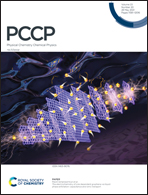In situ electrochemical Raman investigation of charge storage in rGO and N-doped rGO†
Abstract
In this study, in situ electrochemical Raman spectroscopy was applied to clarify the charge storage mechanism in three types of anodes, synthetic graphite, reduced graphene oxide (rGO), and nitrogen-doped reduced graphene oxide (N-rGO). The Li+ intercalation phenomenon was measured in LiPF6 electrolyte solution using a modified coin cell setup. The synthetic graphite anode showed the splitting of the G peak at the potential E < 0.2 V vs. Li/Li+, corresponding to the formation of a graphite intercalation compound (GIC) and its second-order 2D peak was found to be red-shifted due to charge transfer and induced strain in the potential region of 0.5 to 0.15 V vs. Li/Li+. In the case of rGO, the lattice defects assisted in large and early intercalation of electrolyte ions, which is confirmed by the red-shift in the G peak (∼36 cm−1) and its early disappearance below 0.3 V vs. Li/Li+, respectively. Unlike rGO, nitrogen vacancies in N-rGO provide active sites for Li+ intercalation, resulting in enhanced charge transfer, displayed by the large red-shift in the G peak (∼55 cm−1) and blue-shift in the D peak. In addition, a new Raman peak at 1850 cm−1 was observed in N-rGO for the first time, corresponding to the formation of a reversible intermediate species from the interaction between Li+ and nitrogen vacancies. This work demonstrates the use of a simple in situ technique to get insight into the nano-carbon electrodes during device operation and to reveal the role of doped nitrogen atoms for Li+ intercalation.



 Please wait while we load your content...
Please wait while we load your content...
